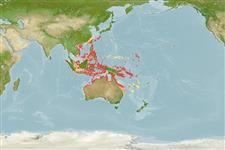Environment: milieu / climate zone / depth range / distribution range
Ecología
marino asociado a arrecife; rango de profundidad 1 - 20 m (Ref. 90102). Tropical; 30°N - 24°S
Western Pacific: Indochina to Papua New Guinea, north to Ryukyu Islands, south to northwestern Australia and the Great Barrier Reef. Replaced by Meiacanthus kamoharai in southern Japan.
Tamaño / Peso / Age
Maturity: Lm ? range ? - ? cm
Max length : 11.0 cm TL macho / no sexado; (Ref. 9710)
Short description
Claves de identificación | Morfología | Morfometría
Espinas dorsales (total) : 4; Radios blandos dorsales (total) : 25 - 28; Espinas anales: 2; Radios blandos anales: 14 - 16. Identified by the lined pattern on the body that ends in spots on the tail-fin base (Ref. 48636).
A solitary species found in sheltered lagoon and seaward reefs (Ref. 9710, 48636). Several adults together occasionally in close vicinity to each other (Ref. 48636). Oviparous. Eggs are demersal and adhesive (Ref. 205), and are attached to the substrate via a filamentous, adhesive pad or pedestal (Ref. 94114). Larvae are planktonic, often found in shallow, coastal waters (Ref. 94114). Several geographical variations and is mimicked by another blenny Petroscirtes breviceps (Ref. 48636). Both fang and venom gland are present (Ref. 57406).
Life cycle and mating behavior
Madurez | Reproducción | Puesta | Huevos | Fecundidad | Larva
Oviparous, distinct pairing (Ref. 205).
Myers, R.F., 1991. Micronesian reef fishes. Second Ed. Coral Graphics, Barrigada, Guam. 298 p. (Ref. 1602)
IUCN Red List Status (Ref. 130435: Version 2024-2)
Human uses
Pesquerías: comercial; Acuario: Comercial
Herramientas
Special reports
Download XML
Fuentes de Internet
Estimates based on models
Preferred temperature (Ref.
123201): 26.4 - 29.3, mean 28.7 °C (based on 1647 cells).
Phylogenetic diversity index (Ref.
82804): PD
50 = 0.5000 [Uniqueness, from 0.5 = low to 2.0 = high].
Bayesian length-weight: a=0.00575 (0.00253 - 0.01308), b=3.06 (2.86 - 3.26), in cm total length, based on LWR estimates for this (Sub)family-body shape (Ref.
93245).
Nivel trófico (Ref.
69278): 3.4 ±0.5 se; based on size and trophs of closest relatives
Resiliencia (Ref.
120179): Alto, población duplicada en un tiempo mínimo inferior a 15 meses (Preliminary K or Fecundity.).
Fishing Vulnerability (Ref.
59153): Low vulnerability (10 of 100).
Nutrients (Ref.
124155): Calcium = 136 [70, 243] mg/100g; Iron = 0.887 [0.517, 1.547] mg/100g; Protein = 18 [17, 19] %; Omega3 = 0.0885 [, ] g/100g; Selenium = 23.6 [11.2, 54.0] μg/100g; VitaminA = 188 [54, 677] μg/100g; Zinc = 2.04 [1.35, 2.94] mg/100g (wet weight);
